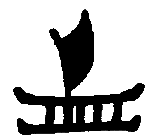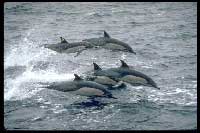
Article
Dolphin Legends in Hawaii
by Serge Kahili King
 There aren't any. Or are there?
There aren't any. Or are there?
Although there are many mysteries and strange happenings to be found in these beautiful islands, one of the most mysterious and strange is the fact that there are no traditional dolphin stories.
Dolphins of four kinds abound in Hawaiian waters. The most commonly seen, and most popular, are the Spinner dolphins, so called because of their habit of leaping into the air and spinning around before falling back into the water. They are often seen in or close to many bays. The Pacific Bottlenose dolphin likes to come close inshore and ride the bow waves of boats. They frequently become permanent residents of some coasts and harbors. Spotted dolphins are commonly seen in the island channels. The Rough-toothed dolphin is most usually found in deep offshore waters.
There are two names for dolphins given in the Pukui-Elbert dictionary: nai'a and nu'ao, neither of which are easy to understand (one of these is translated as "porpoise," but "porpoise" and "dolphin" are commonly used interchangeably, even though, technically, there are no porpoises in Hawaiian waters). Nai'a quite possibly simply means "sea creatures" (na = plural, i'a = fish or any sea creature). Nu'ao has tantalizing roots that could mean "whistling multitude," but that's a stretch. Unfortunately, we really don't know what those names refer to.
Dolphin interactions with humans have been recorded around the world since very ancient times. Among these behaviors are: surfing alongside human surfers, cooperating with humans for fishing, establishing bonds of friendship with individual humans, protecting humans from sharks, assisting ill or injured human swimmers, and guiding humans to safety or to fishing grounds.
And yet, there are no dolphin stories in Hawaii. Even more curiously, all the above behaviors have been attributed to a different sea creature in Hawaiian legends. So I have a theory.
In all the books I have read about Hawaiian legends and mythology, there are numerous references to sharks, but none to dolphins. This has always struck me as rather strange, but it was not until I read a shark story in "Myths and Legends of the Polynesians" by Johannes C. Andersen that I got my first clue as to why this might be so.
In a story from Mangaia, the most southerly of the Cook Islands, the goddess 'Ina (the equivalent of the Hawaiian Hina) is using a shark to help her with various tasks when she cracks a coconut open on the shark's forehead, and this is why, in the words of the story, "From that day there has been a protuberance on the forehead of all sharks, known as the 'bump of 'Ina'."
Well, in spite of what the story says, sharks do not have bumps on their foreheads, but dolphins do. In re-reading all the shark stories I could find I noticed a large number of behaviors described that are characteristic of dolphins, but not sharks.
My conclusion is that the most common word for a shark, which is mano in Hawaiian, was originally a generic term that included both dolphins and sharks, and that for some unknown reason translators applied it only to sharks. Mano is always translated as "shark," even though one type of shark that, by Hawaiian tradition. rested its head on the bow of a canoe and was fed and loved by fishermen, was called mano ihu wa'a, which means "Mano with a beak like the prow of a canoe."
If my theory is valid, then there are many dolphin stories in Polynesian legends. Dolphins are just traveling through the literature disguised as sharks - and maybe laughing about it.
[Top of page] - Contact us